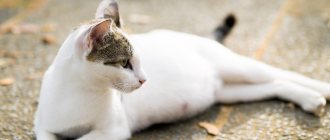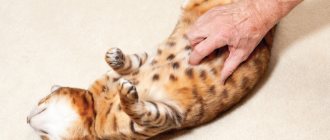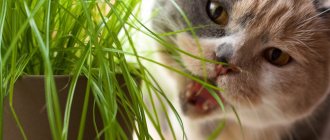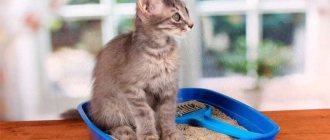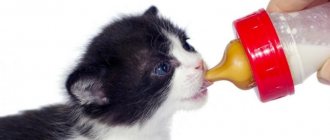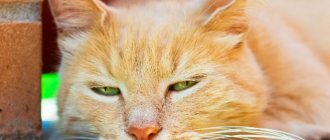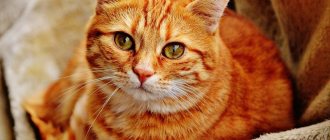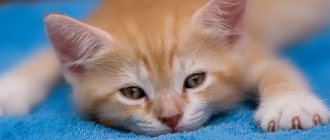Cats, like any living organism, are often exposed to diseases of various etiologies. Quite often, owners of four-legged animals at a veterinarian’s appointment note that the cat cannot swallow. This is a fairly common ailment among cats, which is medically classified as dysphagia. The disease is manifested by the inability to swallow food or a difficult swallowing process, as well as food getting into the nasal passages and respiratory organs. The process is quite dangerous, as it can lead to blockage of the respiratory tract and death of the animal. Adaptive behavior is very often observed, that is, a specific twitching of the head while eating. Thus, the cat tries to push food into the esophagus. If a characteristic symptom is detected, it is recommended to take your pet to a specialist for examination and clarification of possible treatment options.
Types of dysphagia
Fights cause dysphagia.
Swallowing disorders are divided into anatomical and functional. Morphological dysphagia can be congenital or acquired due to injury. Functional ones develop as a result of inflammatory or neurological diseases.
Based on localization, the following types of disorders are distinguished:
- Oral: The animal is unable to grasp food or form a bolus using the tongue and mouth. The cat chews for a long time, shaking its head so that the food falls into the throat.
- Pharyngeal: the relationship with the swallowing and gag reflexes is disrupted. Some of the food is regurgitated and ends up in the nasal passages. If the larynx becomes blocked, the pet dies from suffocation.
- Esophageal or esophageal. Food gets stuck in the esophagus and does not enter the stomach. A cough occurs, causing vomiting. The animal is starving and quickly loses weight.
Causes of swallowing disorders
Gingivitis
The swallowing process is disrupted under the influence of the following pathogenic factors:
- Mechanical: occur when a foreign object is inserted into the soft tissues of the mouth or the food tube is blocked. An embedded fish bone causes pain and interferes with the act of swallowing. A curious pet plays with small parts of toys or devices scattered on the floor, swallows them and blocks the lumen of the pharynx or esophagus.
- Traumatic: damaged soft tissues become inflamed and swollen, pain or narrowing of the food passage due to a formed scar prevents swallowing.
- Congenital: anatomical abnormalities prevent the normal passage of the food coma. Most often they occur during spontaneous selection, when mating partners are not selected taking into account pedigrees.
- Errors in feeding , in which food particles are retained on the gums. Plaque occurs, tartar forms, and gingivitis develops. The act of swallowing becomes painful.
- Inflammation of the lymph nodes due to hypothermia from frozen food, burns that are too hot, and infectious diseases.
- Formation of ulcerative defects of the mouth as a result of calicivirus infection.
- Paralysis of the masticatory muscles due to tick-borne or viral infection, poisoning, autoimmune processes.
- Swelling of the pharynx under the influence of irritating factors
- Traumatic brain injuries.
- Tumors.
Be sure to read:
Why does a cat have blood from under its tail: is it flowing or dripping, what should the owner do, should he worry?
Causes of the disorder
The causes of swallowing disorders are usually divided into several large groups:
- mechanical;
- traumatic;
- caused by infectious brain damage;
- caused by damage to the cranial nerves.
Oral distress can be caused by trauma to the jaw, dental disease, or abscesses in the mouth or throat. In this case, swallowing is impaired due to acute pain. If an animal is injured, there may be visible violations of the integrity of the bones, blood in the saliva, bad breath, and an abscess leads to deformation of the jaw at the site of formation.
Lymphadenopathy (inflammation of the lymph nodes of a bacterial nature or the formation of tumors) in the submandibular region leads to visible deformation of the neck, difficulty swallowing, the animal may be apathetic, its temperature rises and all other signs of general intoxication appear.
Congenital anomalies (cleft palate or short frenulum of the tongue) make it difficult for the animal to eat without losing its appetite. With a cleft palate, some of the food gets into the nose, the animal may sneeze and cough, and choke.
Swelling of the pharynx due to allergies or inflammation leads to a narrowing of the pharyngeal ring and difficulty in moving food. Allergies can cause laryngospasm and suffocation.
Ordinary myositis, inflammation of the masticatory muscles, can lead to impaired swallowing. Due to pain and dysfunction, it is difficult for the animal to chew food. Dysphagia can be caused by infectious polymyositis caused by toxoplasmosis.
Damage to the nerves (trigeminal, glossopharyngeal, cranial) leads to the inability of the animal to move food using the tongue; it tries to solve the problem using adaptive behavior.
Swallowing disorders can develop after a stroke, traumatic brain injury, and some other pathologies affecting the animal’s brain. In this case, the cat experiences not only a loss of the ability to swallow, but also other disorders, paralysis, and loss of consciousness.
Autoimmune diseases, polyneuropathy, muscular dystrophy that affects the masticatory apparatus lead to the fact that the animal cannot perform the usual chewing and swallowing movements.
Some infectious diseases lead to muscle damage or disruption of the transmission of nerve impulses to the masticatory muscles, for example, botulism, rabies, tick-borne encephalitis. All these diseases are accompanied by their characteristic symptoms.
A foreign body is one of the most common causes of swallowing disorders in animals. Particularly often affected are cats whose owners feed them fish or allow them to gnaw on the tubular bones of birds. In this case, the bone can get stuck in the soft tissues of the palate or pharynx, the animal coughs, vomits, and tries to scratch with its paws near the cheeks and mouth. In this case, there is no need to feed him bread or water to “promote” the bone, because any foreign body can injure the esophagus and intestines and cause internal bleeding or peritonitis. It's better to take him to the vet.
Clinical symptoms and diagnosis
With calcivirosis, problems occur with swallowing due to ulcers on the tongue.
Dysphagia can be suspected based on the following pathological symptoms:
- profuse salivation with or without blood;
- cough and regurgitation after feeding;
- gagging;
- chewing food on one side of the jaw if dental disease has occurred on the other;
- halitosis - stench from the mouth;
- crusts around the nose;
- picky eating;
- exhaustion;
- curvature of the neck;
- head shaking;
- plaintive meowing for no apparent reason.
The initial diagnosis is made by the cat owner if he notices at least 2 or 3 of the listed pathological signs. The cause of the disease is determined based on a clinical examination of the medical history and additional studies prescribed by a veterinarian.
Types and signs
According to the nature of the development of the disease, two forms are distinguished:
- chronic – the animal’s throat hurts for several months.
- acute - develops instantly. The animal's temperature rises, it hurts the cat to swallow, and the number of leukocytes and ESR in the blood increases. It is more difficult to tolerate than chronic, but goes away quickly with well-chosen treatment.
According to the nature of the course of inflammation, depending on the microorganism that caused the disease, several types are distinguished:
- catarrhal - determined by tingling in the throat and pain when swallowing. In cats, the pharynx becomes inflamed, the tonsils are slightly enlarged, a whitish coating is noticeable on the tongue, the temperature is slightly higher than normal, and in rare cases the voice disappears.
- croupous - determined by swelling and compression of the swallowing ring, the temperature is 2-3 degrees above normal. When the disease is severe, breathing becomes impaired, shortness of breath appears, the cat refuses food and water, the throat hurts, and the mucous membrane becomes pale. A cough appears when trying to eat food, and unpleasant discharge comes out of the nose; the cat cannot meow, but can only wheeze.
- diphtheria - determined by a gray-white coating, a temperature much higher than normal, infection of the mucous membranes of the mouth and nose, and even blood. Happens rarely.
- ulcerative - determined by small ulcers on the pharyngeal mucosa, especially in the tonsil area. The temperature may be normal.
© shutterstock
Treatment and prevention
Feeding through a nasoesophageal tube
Treatment consists of eliminating the cause of the disease and diet therapy.
For conservative treatment, medications of the following groups may be needed:
- antibiotics;
- immunomodulators;
- anti-inflammatory corticosteroid drugs;
- external wound healing agents.
Since swallowing is difficult, food is served in liquid form; if it is refused, it is forcibly administered through a nasoesophageal tube.
Restorative procedures involve parenteral administration of a mixture of electrolytes and detoxifiers, and, if necessary, water-soluble vitamins.
Surgical treatment is used to remove a foreign body, remove a diseased tooth or tumor. Congenital anomalies, as well as certain traumatic injuries, cannot be treated.
Teeth cleaning
Prevention consists of the following actions:
- Complete nutrition with prepared food of at least premium class. If plaque forms, use special food to remove food debris from the teeth and gums.
- Use natural cat toothpaste and brush.
- Do not treat your pet to fish with bones that could get stuck in the mouth or throat.
- Do not scatter small parts of toys or devices on the floor that your pet could swallow.
- Do not offer frozen or too hot treats.
- Vaccinate your pet in a timely manner in accordance with the vaccination plan.
- Use insectoacaricidal agents to protect the animal from arthropods.
- Carefully select pairs for mating. Eliminate the possibility of inbreeding.
Be sure to read:
Discharge from the eyes in cats: normal or pathological, causes, what to do, treatment and prevention
Associated symptoms
When a cat is unable to swallow food, a number of accompanying signs are observed that allow a diagnosis of dysphagia to be made. The owners observe how the cat coughs heavily and constantly spits out or regurgitates food while eating. Sneezing indicates that food is getting into the cat's nasal passages. The pet also quickly loses body weight, and the process of eating food becomes a whole problem for the animal. A rather unpleasant odor emanates from the cat's mouth. While eating, the pet shakes and throws its head back, which causes neck asymmetry. If you detect even a couple of the above signs, you should contact a specialist.
Treatment depends on the cause of the disease. If injuries have been sustained, surgeries are performed to restore the shape of the jaw. Diseases of the trigeminal nerve or central nervous system are treated with sedatives; inflammatory processes require treatment with antibiotics and corticosteroids. All medications are prescribed by a doctor after accurately identifying the cause of dysphagia. During treatment, the diet must be followed. It is very important to give your pet enough food and water. In severe cases, feeding through a feeding tube may be recommended - a special tube leading into the esophageal canal. All food must be liquid. To restore the balance of nutrients, drips with glucose and vitamins may be prescribed. Self-medication is excluded. If signs of illness are detected, treatment must be started immediately, avoiding complications and the development of other diseases with the digestive system.
